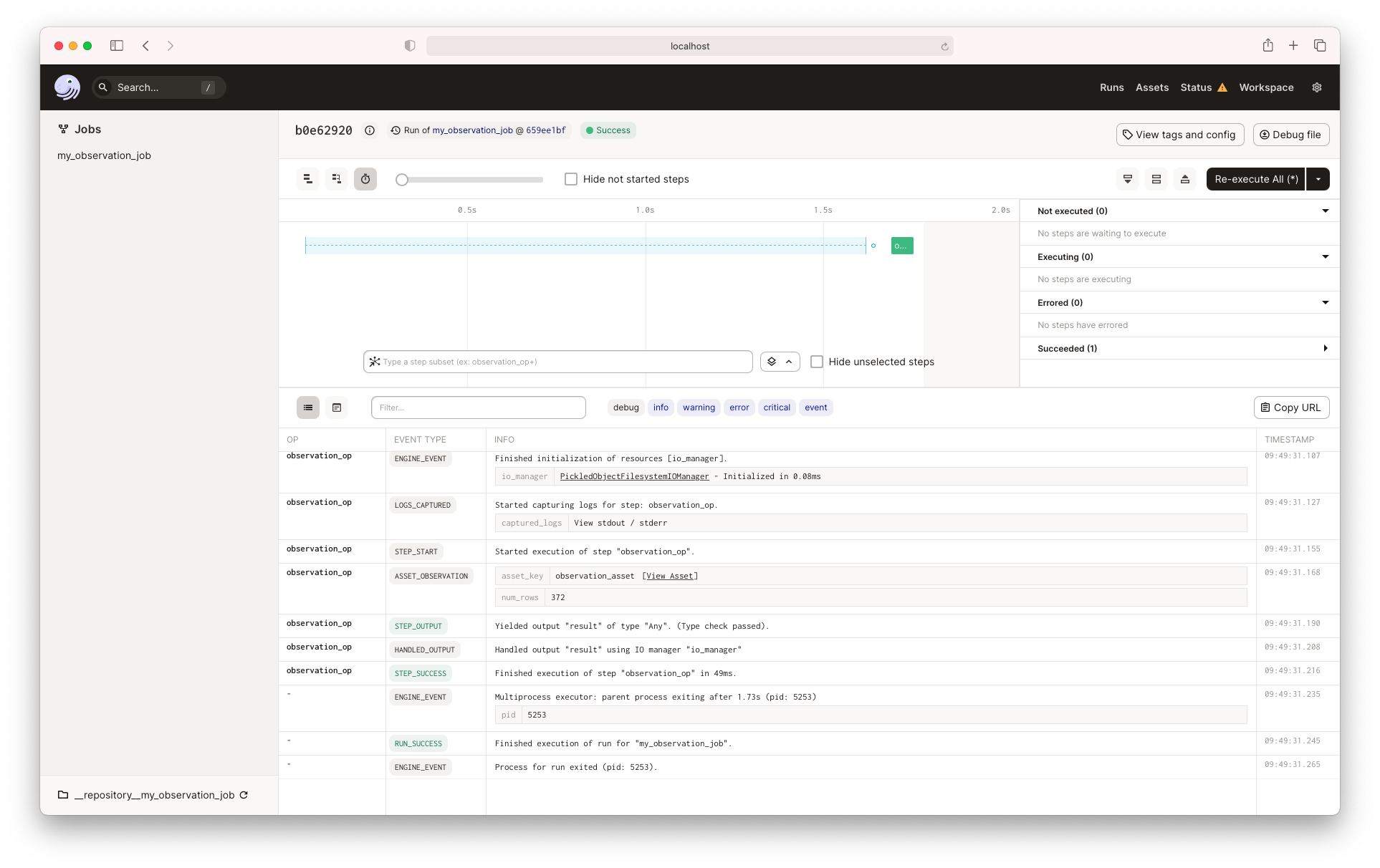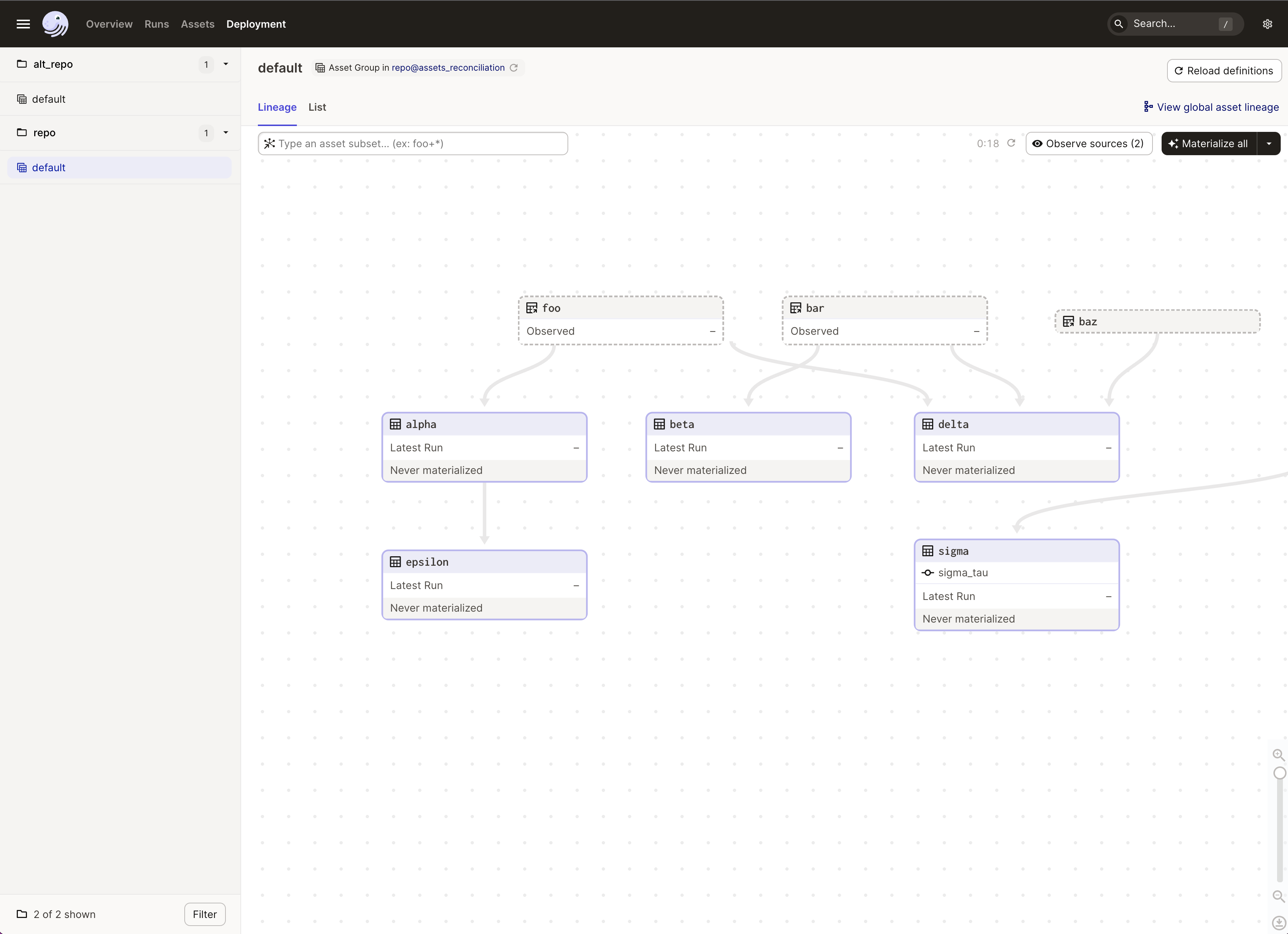Asset observations
An asset observation is an event that records metadata about a given asset. Unlike asset materializations, asset observations do not signify that an asset has been mutated.
Relevant APIs
| Name | Description |
|---|---|
AssetObservation | Dagster event indicating that an asset's metadata has been recorded. |
AssetKey | A unique identifier for a particular external asset. |
Overview
AssetObservation events are used to record metadata in Dagster
about a given asset. Asset observation events can be logged at runtime within ops and assets. An asset must be defined using the @dg.asset decorator or have existing materializations in order for its observations to be displayed.
Logging an AssetObservation from an op
To make Dagster aware that we have recorded metadata about an asset, we can log an AssetObservation event from within an op. To do this, we use the method OpExecutionContext.log_event on the context:
import dagster as dg
@dg.op
def observation_op(context: dg.OpExecutionContext):
df = read_df()
context.log_event(
dg.AssetObservation(
asset_key="observation_asset", metadata={"num_rows": len(df)}
)
)
return 5
We should now see an observation event in the event log when we execute this asset.

Attaching Metadata to an AssetObservation
There are a variety of types of metadata that can be associated with an observation event, all through the MetadataValue class. Each observation event optionally takes a dictionary of metadata that is then displayed in the event log and the Asset Details page. Check our API docs for MetadataValue for more details on the types of event metadata available.
import dagster as dg
@dg.op
def observes_dataset_op(context: dg.OpExecutionContext):
df = read_df()
remote_storage_path = persist_to_storage(df)
context.log_event(
dg.AssetObservation(
asset_key="my_dataset",
metadata={
"text_metadata": "Text-based metadata for this event",
"path": dg.MetadataValue.path(remote_storage_path),
"dashboard_url": dg.MetadataValue.url(
"http://mycoolsite.com/url_for_my_data"
),
"size (bytes)": calculate_bytes(df),
},
)
)
return remote_storage_path
In the Asset Details page, we can see observations in the Asset Activity table:

Specifying a partition for an AssetObservation
If you are observing a single slice of an asset (e.g. a single day's worth of data on a larger table), rather than mutating or creating it entirely, you can indicate this to Dagster by including the partition argument on the object.
import dagster as dg
class MyOpConfig(dg.Config):
date: str
@dg.op
def partitioned_dataset_op(context: dg.OpExecutionContext, config: MyOpConfig):
partition_date = config.date
df = read_df_for_date(partition_date)
context.log_event(
dg.AssetObservation(
asset_key="my_partitioned_dataset", partition=partition_date
)
)
return df
Observable source assets
SourceAsset objects may have a user-defined observation function
that returns a DataVersion. Whenever the observation
function is run, an AssetObservation will be generated for
the source asset and tagged with the returned data version. When an asset is
observed to have a newer data version than the data version it had when a
downstream asset was materialized, then the downstream asset will be given a
label in the Dagster UI that indicates that upstream data has changed.
AutomationConditions can be used to automatically
materialize downstream assets when this occurs.
The observable_source_asset decorator provides a convenient way to define source assets with observation functions. The below observable source asset takes a file hash and returns it as the data version. Every time you run the observation function, a new observation will be generated with this hash set as its data version.
from hashlib import sha256
import dagster as dg
@dg.observable_source_asset
def foo_source_asset():
content = read_some_file()
hash_sig = sha256()
hash_sig.update(bytearray(content, "utf8"))
return dg.DataVersion(hash_sig.hexdigest())
When the file content changes, the hash and therefore the data version will change - this will notify Dagster that downstream assets derived from an older value (i.e. a different data version) of this source asset might need to be updated.
Source asset observations can be triggered via the "Observe sources" button in the UI graph explorer view. Note that this button will only be visible if at least one source asset in the current graph defines an observation function.

Source asset observations can also be run as part of an asset job. This allows you to run source asset observations on a schedule:
import dagster as dg
@dg.observable_source_asset
def foo_source_asset():
content = read_some_file()
hash_sig = sha256()
hash_sig.update(bytearray(content, "utf8"))
return dg.DataVersion(hash_sig.hexdigest())
observation_job = dg.define_asset_job("observation_job", [foo_source_asset])
# schedule that will run the observation on foo_source_asset every day
observation_schedule = dg.ScheduleDefinition(
name="observation_schedule",
cron_schedule="@daily",
job=observation_job,
)
Currently, source asset observations cannot be run as part of a standard asset job that materializes assets. The selection argument to define_asset_job must target only observable source assets-- an error will be thrown if a mix of regular assets and observable source assets is selected.